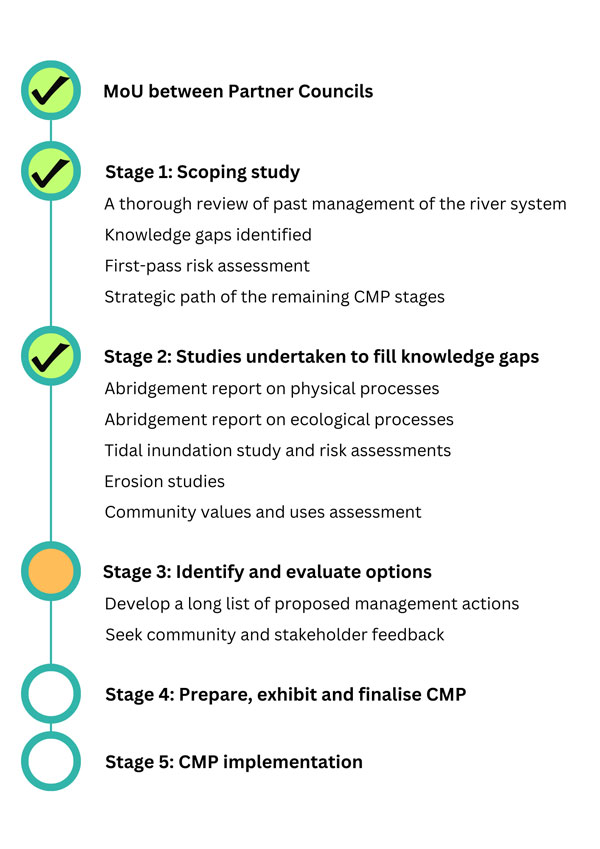Waterways are a huge part of the Hornsby Shire community’s lifestyle. They underpin our identity, support our local economy, provide recreational and social opportunities for locals and visitors, and support our mental and physical wellbeing.
A great deal of planning and research has been undertaken within the Hawkesbury River system throughout the years. Up to now, the River has often been managed in a segmented approach to address locally specific issues or through estuary management and other plans across smaller sections of river and catchments that align with local council areas. Estuary Management Plans were developed for Berowra and Brooklyn area which then were combined into the Lower Hawkesbury Estuary Management Plan in 2008 (Wisemans Ferry to Junio Point). This plan included strategies in the following themes:
- Planning – ensuring planning instruments include best practice and provisions for sustainable development
- Research – undertaking programs to monitor estuarine health and prepare for climate change
- Education – engaging local communities and schools through estuary awareness activities
- Compliance – encouraging riverside settlements to implement sustainable practices
- On-ground works – installing infrastructure and undertaking regeneration programs to protect estuarine assets.
Currently Hornsby Shire Council is working on two key projects aim to protect and improve estuary and catchment planning through development of Coastal Management Programs (CMPs) for the Hawkesbury-Nepean River and Sydney Harbour. Both projects are supported by the NSW Government’s Coastal and Estuary Grant Program.
Under the Coastal Management Act 2016 No 20 - NSW Legislation (CM Act) councils may prepare CMPs which set out the long-term strategy for the coordinated management of the coast, with a focus on achieving the objects and objectives of the CM Act. The CMPs will be developed and guided by the NSW State Government's Coastal Management Manual.
CMPs identify management issues in the coastal area, the actions required to address these issues, and how and when those actions will be implemented. They detail costs and proposed cost-sharing arrangements and other viable funding mechanisms.
Hawkesbury-Nepean CMP
Hornsby Shire Council is leading a partnership with the other five Councils that have management responsibility of land and coastline along the river, to prepare a Coastal Management Program (CMP) for the Hawkesbury-Nepean River System. The project covers the area of estuary between Yarramundi (the tidal limit of the river) to the estuary entrance between Box Head and Barrenjoey Head and includes Brisbane Water, Broken Bay and Pittwater.
Our partnering councils are: Hawkesbury City Council, The Hills Shire Council, Central Coast Council, Ku-ring-gai Council and Northern Beaches Council. Having the six Councils working together on this project means we can use an integrated approach to manage the Hawkesbury estuary/river on issues that cross jurisdictional boundaries.
The CMP will set out the long-term strategy for the coordinated management of the coastal zone along the Hawkesbury including its creeks, lagoons, littoral rainforests, wetlands, beaches and associated catchments. The program will focus on achieving coastal management objectives at a local level whilst, also achieving the objectives of the NSW Coastal Management framework.
The CMP will provide:
- an opportunity for councils, public authorities and local communities to identify and balance competing interests and priorities in the coastal zone
- implement NSW government guidelines for coastal management
- provide recommendations for the future management of the Hawkesbury-Nepean River system
- The CMP will guide how issues will be dealt with, who is responsible, where funding will come from and when actions will be undertaken.
In March 2024, the project received additional funding to deliver Stages 3-4 of the CMP. To view the latest information about the CMP progress and all the planned stakeholder and community engagement activities, please visit our CMP website. You can also be kept informed about the CMP by registering your interest.

Useful links
Sydney Harbour CMP
Twenty councils within the Greater Sydney Harbour catchment are collaborating with state agencies to develop a whole-of-system approach through a Greater Sydney Harbour Coastal Management Program (GSHCMP). The Sydney Coastal Councils Group (SCCG) is project managing the delivery of this CMP.
Stage 1 Scoping Study has identified urban stormwater discharge as a high priority threat to environmental and public health.
Sydney Harbour Water Quality Improvement Plan has also been completed and provides a strong base for the development of the GSHCMP.
To assess threats posed by pollutants being carried into Sydney Harbour waters, a Stage 2 investigation will determine risks across all catchments feeding the Harbour and steps needed to mitigate those risks. The aim is to provide support for coordinated action by councils, in partnership with state agencies and the community, to facilitate integrated waterway health management for the entire Greater Sydney Harbour system. This Stage 2 investigation will bring together available information on urban stormwater and apply existing tools (such as the Risk Based Framework) in a coordinated way. It will also enable individual councils to work with State Agencies to develop projects/actions for consideration in Stage 3. The investigation will also involve community and stakeholder engagement.
Useful links